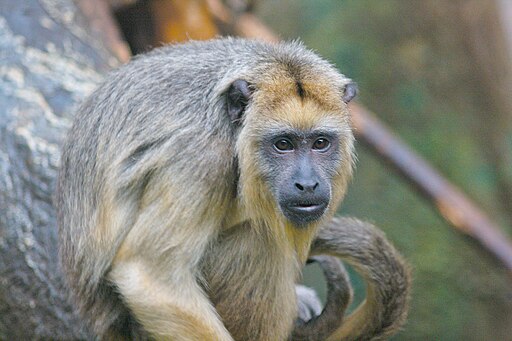Superregnum: Eukaryota
Regnum: Animalia
Subregnum: Eumetazoa
Cladus: Bilateria
Cladus: Nephrozoa
Superphylum: Deuterostomia
Phylum: Chordata
Cladus: Craniata
Subphylum: Vertebrata
Infraphylum: Gnathostomata
Superclassis: Tetrapoda
Cladus: Reptiliomorpha
Cladus: Amniota
Cladus: Synapsida
Cladus: Eupelycosauria
Cladus: Sphenacodontia
Cladus: Sphenacodontoidea
OrdoTherapsida
Cladus: Theriodontia
Subordo: Cynodontia
Cladus: Mammaliaformes
Classis: Mammalia
Subclassis: Trechnotheria
Infraclassis: Zatheria
Supercohort: Theria
Cohort: Eutheria
Cohort: Placentalia
Cladus: Boreoeutheria
Superordo: Euarchontoglires
Ordo: Primates
Subordo: Haplorhini
Infraordo: Simiiformes
Parvordo: Platyrrhini
Familia: Atelidae
Subfamilia: Alouattinae
Genus: Alouatta
Species: Alouatta caraya
Name
Alouatta caraya (Humboldt, 1812)
References
Alouatta caraya (Humboldt, 1812) – Taxon details on Integrated Taxonomic Information System (ITIS).
IUCN: Alouatta caraya (Humboldt, 1812) (Least Concern)
Vernacular names
English: Black Howler
español: mono aullador negro
português: Guariba, Bugio
русский: Чёрный ревун
Türkçe: Kara elli uluyan maymun
The black howler (Alouatta caraya) (also known as black-and-gold howler[2]) is a species of howler monkey, a large New World monkey, from northeastern Argentina, eastern Bolivia, eastern and southern Brazil, and Paraguay. Together with the brown howler, it is the southernmost member of the Alouatta genus. Only the adult male is black; adult females and juveniles of both genders are overall whitish to yellowish-buff.[3] However, variations occur even among the adult males; some have patches of reddish-brown or buff fur.[3]
Two females in a tree branch, using their strong prehensile tail as a safety fifth limb, in Pantanal, Bolivia
They live in groups of three to 19 individuals (usually seven to 9). The sex ratio is usually one to three males for every seven to nine females in a group. Mating occurs within the group.
Named for their vocalizations, they may be heard most often around sunrise. This "dawn chorus" sounds much more like roaring than howling, and it announces the howlers' position as a means to avoiding conflict with other groups. The call can be heard up to 5 km away.
These monkeys commonly sleep or rest up to 70% of the day,[2] making it one of the least active monkeys in the New World. Their habitat is forest, especially semideciduous and gallery.[2] Black howlers are folivorous, eating mostly leaves,[4] and occasionally fruit, such as figs. They generally prefer walking and climbing to running or leaping. The prehensile tail is very strong and acts as a fifth limb, allowing the monkeys greater versatility when climbing and allowing them greater safety in the occasional fall from a high branch. Because their limb structure makes terrestrial movement awkward, they spend most of their time in the trees and only come down for water during dry spells. Otherwise, the monkeys drink by wetting their hands on moist leaves, and then licking the water off their hands. Their lifespans are up to 20 years, but more commonly 15 years in the wild. In Argentina it is commonly kept as a pet due to its gentle nature.
Female at the Apenheul Primate Park
References
Groves, C. P. (2005). Wilson, D. E.; Reeder, D. M. (eds.). Mammal Species of the World: A Taxonomic and Geographic Reference (3rd ed.). Baltimore: Johns Hopkins University Press. p. 148. ISBN 0-801-88221-4. OCLC 62265494.
Bicca-Marques, J., Alves, S.L., Boubli, J., Cornejo, F.M., Cortes-Ortíz, L., Jerusalinsky, L., Ludwig, G., Martins, V., de Melo, F.R., Messias, M., Miranda, J., Rumiz, D.I., Rímoli, J., Talebi, M., Wallace, R., da Cunha, R. & do Valle, R.R. 2020. Alouatta caraya. The IUCN Red List of Threatened Species 2020: e.T41545A17924308. Retrieved 9 July 2020.
Gregorin, R. (2006). (in Portuguese) Taxonomia e variação geográfica das espécies do gênero Alouatta Lacépède (Primates, Atelidae) no Brasil. Rev. Bras. Zool. 23(1).
National Geographic
Louise Emmons and Francois Feer. (1997). Neotropical Rainforest Mammals.
Retrieved from "http://en.wikipedia.org/"
All text is available under the terms of the GNU Free Documentation License



